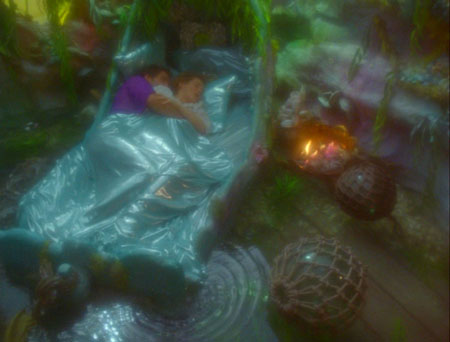DIRECTED BY: Guy Maddin
FEATURING: Alice Krige, Shelley Duvall, Frank Gorshin
PLOT: A prisoner returns to his childhood home on an ostrich farm in a

mythical northern land during the constant daylight of the summer season, where he becomes involved with two mysterious women.
WHY IT WON’T MAKE THE LIST: Twilight of the Ice Nymphs is plenty weird enough to make the List, although it can be such slow going that many folks will tune out before discovering it’s weirder points. Twilight just isn’t good enough. With several of director Guy Maddin’s more effective films already slated for inclusion, it makes little sense to allow a lesser effort, weird though it may well be, to take space away from a more deserving contender.
COMMENTS: Twilight of the Ice Nymphs is set in a suitably colorful and mythic locale, an imaginary land with Nordic overtones and ostriches, but it’s dragged down by an uninspiring hero in an uninvolving storyline, ponderous dialogue, and uneven acting. The protagonist, Peter (Nigel Whitmey), is subject to bouts of sleep-hunting, and also, it seems, to episodes of sleep-acting. For most of the movie his emotional range is so low-key that it barely registers: he covers a scale from glum to mildly perturbed. It doesn’t help that Whitmey’s dialogue was dubbed in by a different actor in post-production after what Maddin hints was a very nasty incident between the director and actor. Peter strikes up no real chemistry with either of his potential lovers, Juliana (whose personal history is obscure) and Zephyr (a wandering woman three months pregnant with her lost husband’s child), so there is little for the audience to root for in this three-way romance. Besides Peter, Pascale Bussières as Juliana is cute but forgettable, Alice Krige’s performance as Zephyr seems on loan from a BBC teleplay, and R.H. Thompson’s evil Dr. Solti is little more than a distracting, hammy faux-Russian accent. Veteran movie actors Shelley Duvall and former Riddler Frank Gorshin put the others to shame, but unfortunately they are pushed into a background subplot.
That said, the film’s visual sensibilities are truly wondrous. Maddin built his magical fairy-forest inside a Winnipeg warehouse, maintaining meticulous control over every aspect of his mise-en-scene. Particularly noteworthy are his brash color schemes: he uses “jewel tones” throughout, and seems particularly fond of placing surrounding emerald hues with bright pinks, magentas, and tangerines, as in a sunset setting over a forest canopy. This makes the movie effective as a slide-show of gorgeous stills; Twilight would probably work well on a big screen TV with the sound turned off as visual wallpaper for a hoity-toity wine-and-cheese party.
Twilight of the Ice Nymphs is available on the DVD, “The Guy Maddin Collection” (buy), along with the feature film Archangel and the award-winning short The Heart of the World.
WHAT THE CRITICS SAY:



